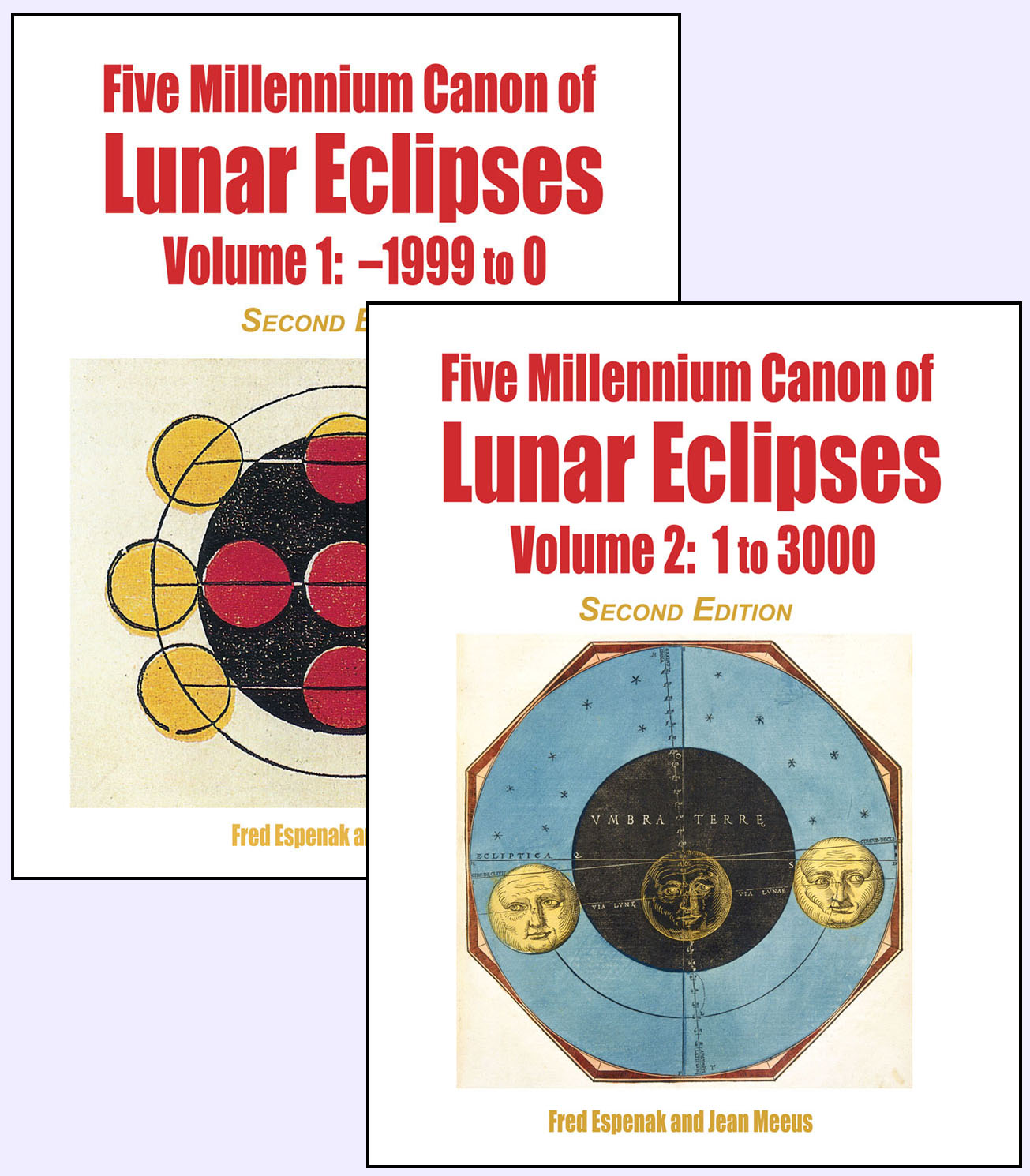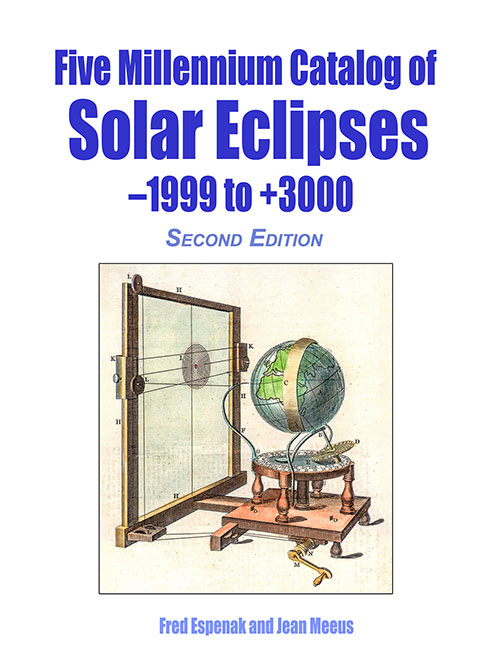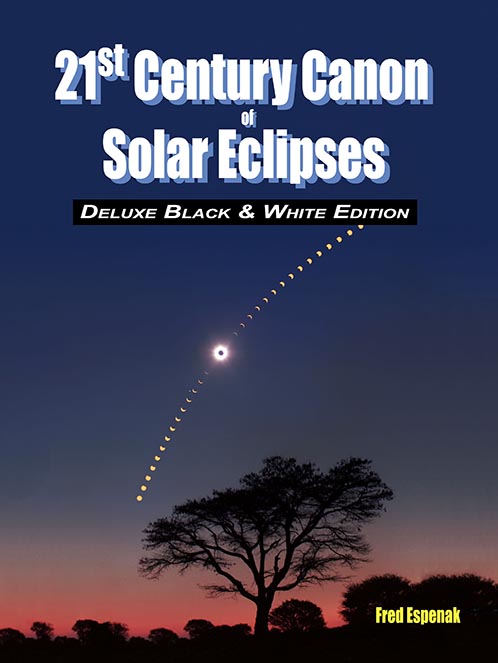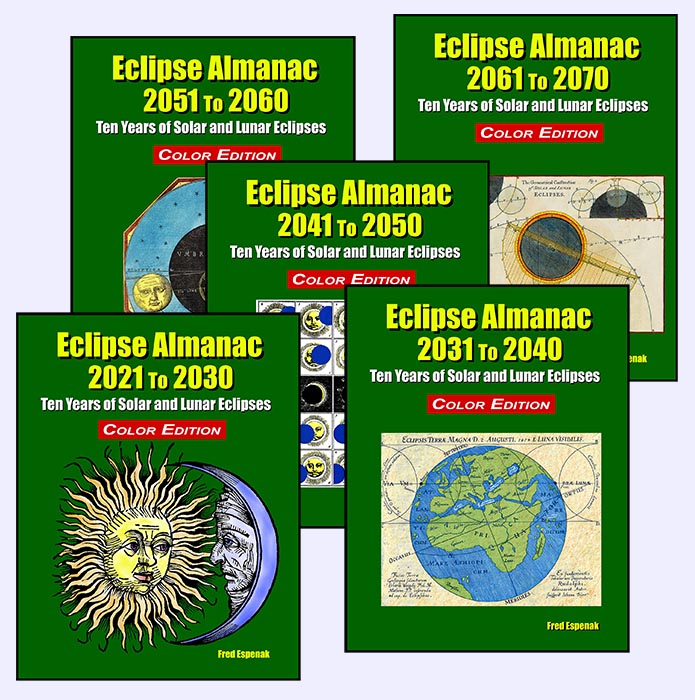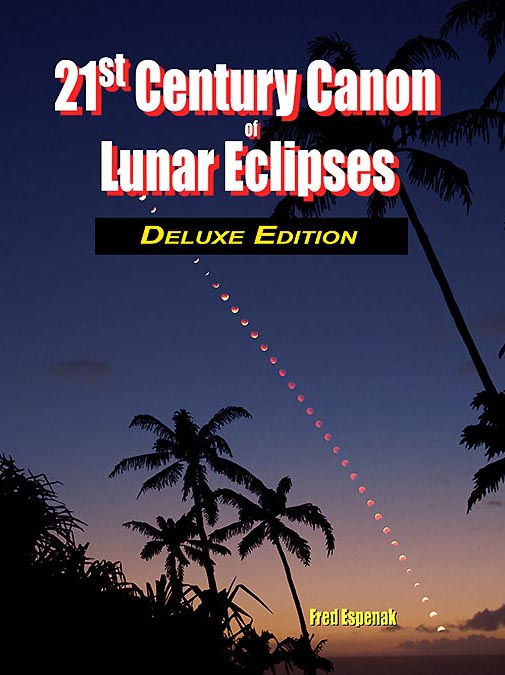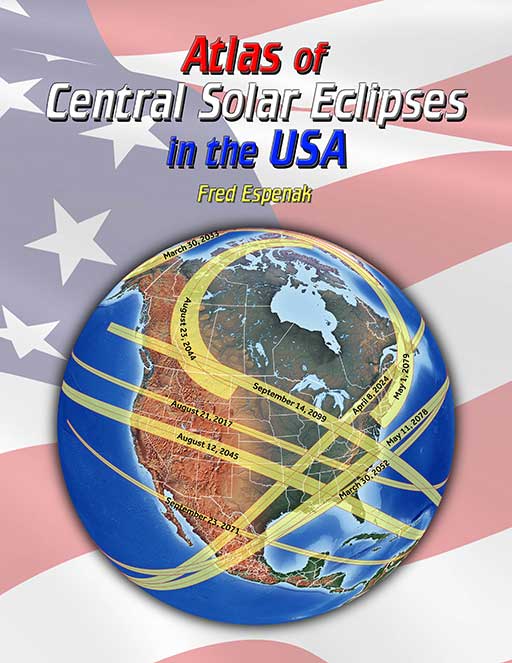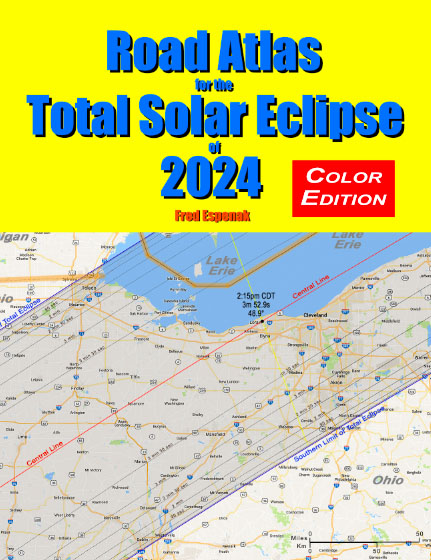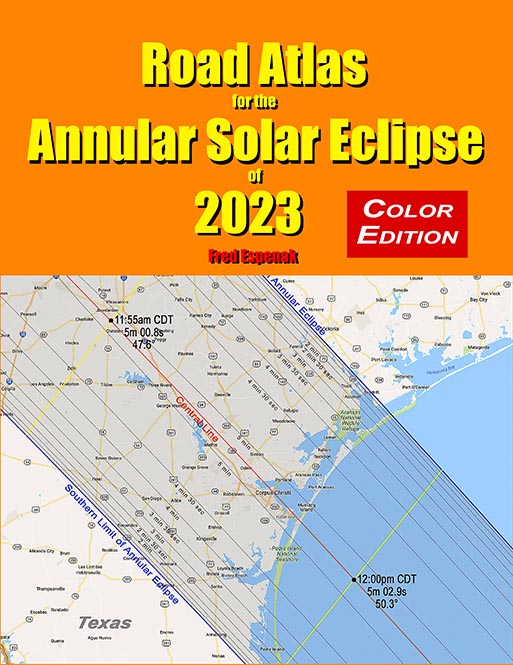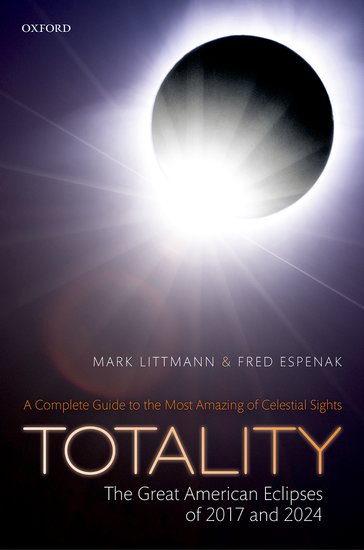Five Millennium Canon of Solar Eclipses
By Fred Espenak and Jean Meeus
Volume 1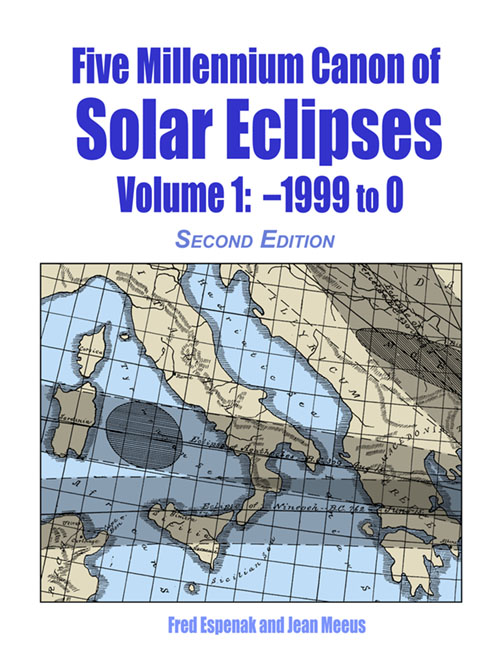
Volume 1 Features |
Volume 1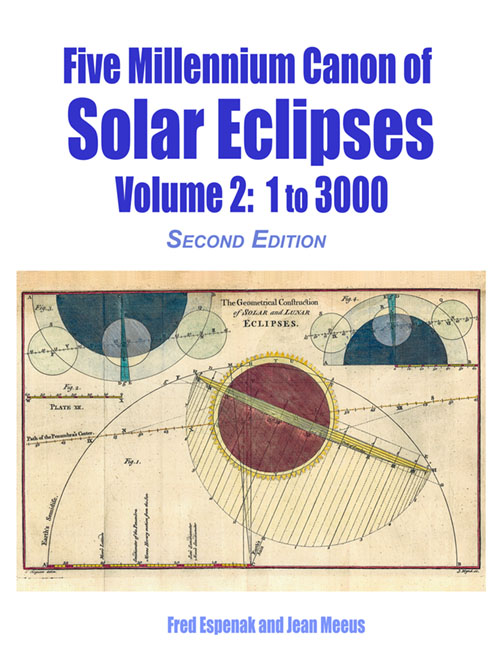
Volume 2 Features |
|
The links above all go to Amazon.com. However, you can order these books from any Amazon worldwide.
Visit any other Amazon and enter the book title in the Amazon search window. |
Description
During the 5,000-year period from -1999 to +3000 (2000 BCE to 3000 CE), Earth will experience 11,898 eclipses of the Sun. The eclipses consist of the following types: 4200 partial eclipses, 3956 annular eclipses, 3173 total eclipses, and 569 hybrid eclipses.
The Five Millennium Canon of Solar Eclipses contains an individual global map for each eclipse illustrating the geographic regions of visibility for both the partial and central (total, annular, or hybrid) phases. Modern political borders are plotted to assist in the determination of eclipse visibility. The uncertainty in Earth's rotational period expressed in delta T and its impact on the geographic visibility of eclipses in the past and future is discussed.
The statistics of the solar eclipse distribution over 5,000 years are discussed in detail. This includes eclipse types by month and by century, eclipse frequency in the calendar year, extremes in eclipse magnitude for all eclipse types, maximum durations of total, annular, and hybrid eclipses, and eclipse duos (two eclipses within 30 days of each other).
Finally, the periodicity of solar eclipses is investigated with particular attention to the Saros cycle. Tables list the start and end dates, number, and type of eclipses of every Saros series in progress during the 5,000-year period covered by the Five Millennium Canon.
The Five Millennium Canon of Solar Eclipses comprises two volumes. Volume 1 covers eclipses for the years -1999 to 0, while Volume 2 covers eclipses for the years 1 to 3000.
Visit the following link to see the Table of Contents.
This link will display the Preface of the Five Millennium Canon.
The key below identifies the features appearing in each eclipse map. Click to open a full-resolution key.
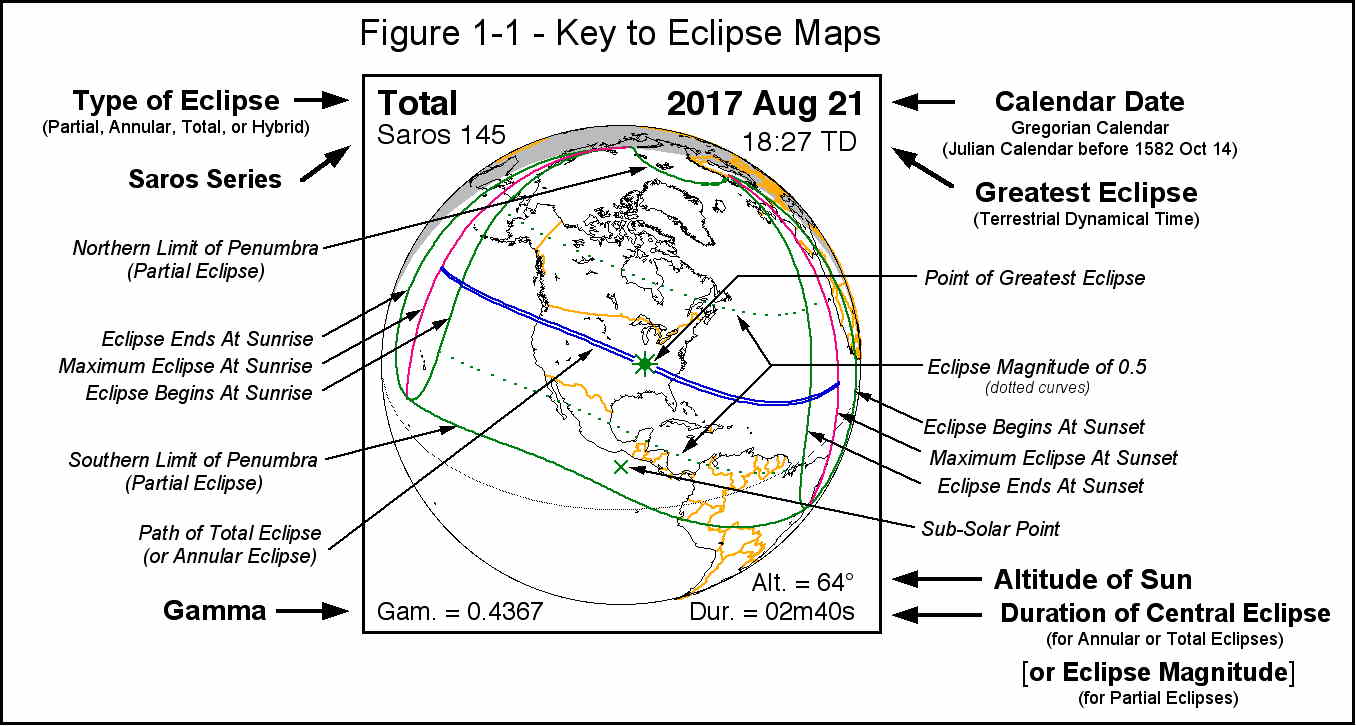
Eclipse Map Key (click to enlarge) |
Below are two example pages from the Appendix of Volume 2. Click on each to open a full-size, full-resolution page.
Plate 478 from Appendix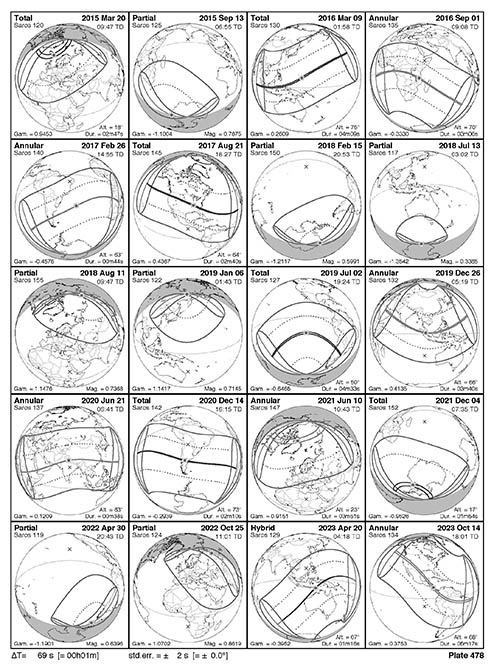
Plate 478 from Appendix (click to enlarge) |
Plate 479 from Appendix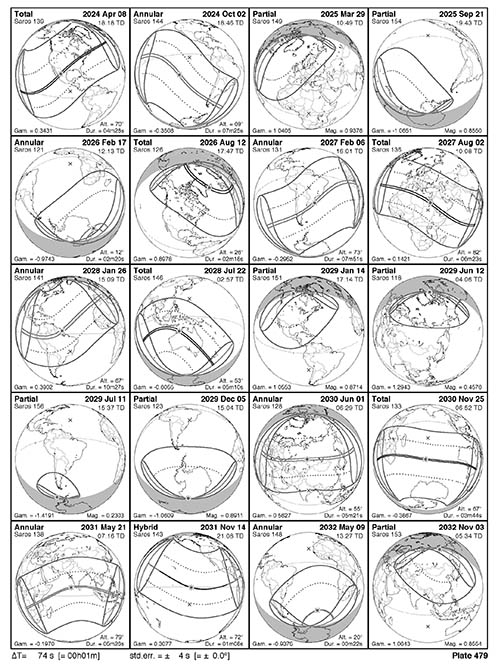
Plate 479 from Appendix (click to enlarge) |
Links for Ordering the Five Millennium Canon and Catalog of Solar Eclipses
Below are links for ordering each edition from Amazon.com:
- Five Millennium Canon of Solar Eclipses - Volume 1: -1999 to 0 (2000 BCE to 1 BCE) - $19.99 (312 pages)
- Five Millennium Canon of Solar Eclipses - Volume 2: 1 to 3000 (1 CE to 3000 CE) - $23.99 (430 pages)
|
The links above all go to Amazon.com. However, you can order these books from any Amazon worldwide.
Visit any other Amazon and enter the book title in the Amazon search window. |
About the Authors
Click the following links to read brief biographies on Fred Espenak and Jean Meeus.
Also Available...
Five Millennium Canon of Lunar Eclipses
The Five Millennium Canon of Lunar Eclipses contains an individual figure and map for each lunar eclipse over 5,000 years. The figures illustrate the Moon’s path through Earth’s shadows while the maps show the regions of visibility of each phase of the eclipse.
The statistics presented include lunar eclipse types by month and by century, extremes in eclipse magnitude, maximum durations of penumbral, partial and total eclipse phases, and eclipse duos.
Finally, the periodicity of lunar eclipses is investigated regarding the Saros cycle. Details of every Saros series in progress during the Five Millennium Canon are tabulated.
The Five Millennium Canon of Lunar Eclipses comprises two volumes comprises two volumes. Volume 1 covers eclipses for the years -1999 to 0, while Volume 2 covers the years 1 to 3000.
For more information visit Five Millennium Canon of Lunar Eclipses.
Five Millennium Catalog of Solar Eclipses: -1999 to +3000
The Five Millennium Catalog of Solar Eclipses: -1999 to +3000 serves to complement the 2-volume Five Millennium Canon of Solar Eclipses. It contains a detailed catalog listing over a dozen parameters for each eclipse including: calendar date, time of greatest eclipse, delta T, Saros number, eclipse type, gamma, eclipse magnitude, geographic coordinates of greatest eclipse, and more.
The statistics of solar eclipse frequency are investigated including eclipse types by century, extremes in eclipse magnitude, and maximum durations of total, annular, and hybrid eclipses.
The Saros cycle shows how it governs the periodicity of eclipses, and details for every of every Saros series in progress are presented.
For more information visit Five Millennium Catalog of Solar Eclipses: -1999 to +3000.
21st Century Canon of Solar Eclipses
The 21st Century Canon of Solar Eclipses contains maps and data for all 224 solar eclipses occurring during the 100-year period from 2001 through 2100. The eclipse predictions are based on the Jet Propulsion Lab's DE405 - a computer ephemeris used for calculating high precision coordinates of the Sun and Moon for hundreds of years into the past and future.
Section 1 of the Canon presents the fundamentals about solar eclipses. Section 2 discusses the eclipse the predictions, the constants used. A statistical analysis of eclipse frequency, extremes in eclipse magnitude, greatest central duration and quincena combinations are covered in Section 3. A concise explanation of the data contained in the solar eclipse catalog (Appendix A) and detailed descriptions of the solar eclipse maps.
The primary content of the "21st Century Canon" resides in the four appendices. Appendix A is a comprehensive catalog of solar eclipses. Appendix B is an atlas of maps (12 per page) depicting the geographic regions of visibility of each eclipse. Appendix C zeros in on full-page maps each solar eclipse. Curves of Maximum Time and Curves of Eclipse Magnitude permit the estimation of time and magnitude from any geographic location. Finally, Appendix D plots the track of every central eclipse (total, annular and hybrid) on large scale maps to allow the identification of countries and major cities within each eclipse path.
For more information visit 21st Century Canon of Solar Eclipses.
Eclipse Almanac
The Eclipse Almanac is a series of five publications. Each one is a concise reference for every eclipse of the Sun and the Moon over a 10-year period. This compendium identifies when and where each of these events will be seen. Particular details about each eclipse are included, as well as a 25-year table looking further into the future.
Section 1 presents solar eclipses including an explanation of why they occur, types of solar eclipses, and the visual appearance of each. Global maps depict the geographic regions of visibility of each of the 22 to 23 solar eclipses.
Section 2 covers lunar eclipses explaning why they occur, the types of lunar eclipses, and the appearance of each. Detailed figures illustrate each of the 22 to 23 lunar eclipses including the Moon's path through Earth's shadows, and a map of the geographic visibility of every eclipse.
Section 3 lists the date and time of the Moon’s phases over the decade.
The five volume Eclipse Almanac series covers the decades from 2021 to 2070.
For more information visit Eclipse Almanac.
21st Century Canon of Lunar Eclipses
The 21st Century Canon of Lunar Eclipses contains figures, maps and data for all 228 lunar eclipses occurring during the 100-year period from 2001 through 2100. The eclipse predictions are based on the Jet Propulsion Lab's DE431 - a computer ephemeris used for calculating high precision coordinates of the Sun and Moon for hundreds of years into the past and future.
Section 1 of the Canon presents the fundamentals about lunar eclipses. Section 2 discusses the eclipse the predictions and the enlargement of Earth's shadows. An analysis of eclipse frequency, and the extremes in penumbral and umbral eclipse magnitudes, and durations of penumbral, partial and total eclipses are covered in Section 3.
The primary content of the "21st Century Canon" resides in the three appendices. Appendix A is a comprehensive catalog of lunar eclipses. Appendix B is an atlas of diagrams (12 per page) depicting the Moon's path through Earth's shadows and the geographic region of visibility of each eclipse. Appendix C zeros in on the lunar eclipses with a detailed full-page path diagrams and maps of each eclipse.
For more information visit 21st Century Canon of Lunar Eclipses.
Atlas of Central Solar Eclipses in the USA
The Atlas of Central Solar Eclipses in the USA contains of a series of 499 global maps showing the geographic track of every total and annular solar eclipse across the USA (including Alaska and Hawaii) during the two-thousand-year period 1001 through 3000. It is accompanied by a catalog that lists the major characteristics of each eclipse including its duration and whether it is visible from the lower 48 states, Alaska and/or Hawaii.
A set of 20 detailed maps, each covering a 50-year period and centered on the lower 48 states, shows the path of every total and annular eclipse. The maps include state boundaries and major cities. These maps also cover southern Canada and northern Mexico.
For more information visit Atlas of Central Solar Eclipses in the USA.
Road Atlas of the Total Solar Eclipse of 2024
The Road Atlas for the Total Solar Eclipse of 2024 contains a comprehensive series of 26 maps of the path of totality across Mexico, the USA and Canada. The large scale (1 inch ≈ 22 miles) shows both major and minor roads, towns and cities, rivers, parks, and mountains.
Although a partial eclipse will be seen from all of North America, the total phase in which the Moon completely covers the Sun (known as totality) will only be seen from within the 120-mile-wide path of the Moon’s umbral shadow as it sweeps across Mexico, the United States (Texas, Oklahoma, Arkansas, Missouri, Tennessee, Kentucky, Illinois, Indiana, Ohio, Michigan, Pennsylvania, New York, Vermont, New Hampshire, and Maine), and Canada (Ontario, Quebec, New Brunswick, Prince Edward Island, Nova Scotia and Newfoundland).
Armed with this atlas and the latest weather forecasts, the road warrior is ready to chase totality no matter where it takes him/her along the entire path. This mobile strategy offers the highest probability of witnessing the spectacular 2024 total eclipse in clear skies.
For more information visit Road Atlas for the Total Solar Eclipse of 2024.
Road Atlas of the Annular Solar Eclipse of 2023
The Road Atlas for the Annular Solar Eclipse of 2023 contains a series of 29 maps of the path of annularity across the USA, Mexico, Central and South America. The large scale (1 inch ≈ 28 miles) shows both major and minor roads, towns and cities, rivers, parks, and mountains.
The annular eclipse phase in which the Moon is completely silhouetted in front of the Sun (known as annularity) will only be seen from within the 115 to 137 mile-wide path of the Moon’s antumbral shadow as it sweeps across the United States (Oregon, California, Idaho, Nevada, Utah, Colorado, Arizona, New Mexico, and Texas), Mexico, Central and South America.
Armed with this atlas and the latest weather forecasts, the road warrior is ready to chase annularity no matter where it takes him/her along the entire path. This mobile strategy offers the highest probability of witnessing the amazing 2023 annular eclipse in clear skies.
For more information visit Road Atlas for the Annular Solar Eclipse of 2023.
Totality - The Great American Eclipses of 2017 and 2024
The Totality - The Great American Eclipses of 2017 and 2024 is a complete guide to the most stunning of celestial sights, total eclipses of the Sun. It focuses on the eclipses of August 21, 2017 and April 8, 2024 that pass across the United States. The U.S. mainland has not experienced a total solar eclipse since 1979. This book provides information, photographs, and illustrations to help understand and safely enjoy all aspects of these eclipses including:
- How to observe a total eclipse of the Sun
- How to photograph and video record an eclipse
- Why solar eclipses happen
- The earliest attempts to understand and predict eclipses
- The mythology and folklore of eclipses
- The response of animals to total solar eclipses
- The response of man to total eclipses through time
- How scientists used total eclipses to understand how the Sun works
- How astronomers used a total eclipse in 1919 to confirm Einstein's general theory of relativity
- Weather prospects for the 2017 eclipse
- Detailed maps of the path of totality for the 2017 eclipse and the eclipses of 2018 through 2024
- Precise local times for the eclipses of 2017 and 2024 (the next total solar eclipse to visit the U.S.)
- Color and black-and-white photographs, diagrams, and charts to illustrate and explain total solar eclipses
- Global maps of total solar eclipses from 2017 to 2045 and lists of total and annual solar eclipses from 1970 through 2070
For more information visit Totality - The Great American Eclipses of 2017 and 2024.


